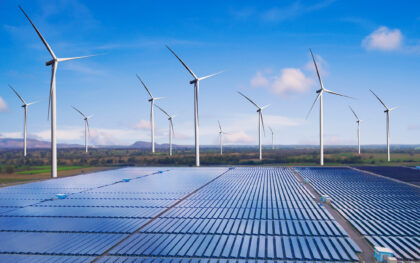Wind Resources – course

Wind Resources
During this course, you will be presented with different issues concerning wind resource assessment.
You will learn how to perform wind resource assessments at various scales, and you will be working with applying your acquired understanding and critical thinking to answer open-ended questions based on practical issues of industrial relevance.
Focus will be on solving various issues from theory to practice through tools and knowledge presented in the course.
Your work will be problem-driven, and the teaching emphasises iterative, active learning, which provides you with the competences needed when working with wind resources in the wind industry.
During the course, you will be working with the following:
- Relevant meteorology (motions and force balances from meso- to planetary-scale and important thermodynamic effects).
- Basic atmospheric boundary layer structure and flow phenomena; micro-and meso-scale modeling and practices, including basic parameterizations and numerical aspects.
- Analysis and use of wind statistics from measurements and models (incl. e.g. wind atlas data).
- Scrutiny of inputs and outputs from wind resource modeling.
Learning objectives
After completing the course, you will be able to:
- List the mechanisms that affect the Annual Energy Production (AEP) of a wind farm.
- Explain the basic driving mechanisms for wind, from global processes down to those linked to the local topography.
- Explain the differences between micro – and mesoscale modelling, and how they can be used together.
- Identify potential errors in the setup of mesoscale and microscale models, through inspection of both inputs/setup and model results.
- Explain the principles, assumptions, and limitations behind a wind atlas (e.g. Global Wind Atlas or regional wind atlases), and use a wind atlas for simple resource estimation.
- Calculate the AEP for simple sites and wind farms, as driven by observations or potentially mesoscale model output.
- Analyse meteorological time series of mean wind and direction with statistical methods.
- Select optimal wind farm layouts based on local conditions.
- Design numerical setup (types of models, parameters, inputs needed) for wind resource assessment campaigns, including observations.
Admission
Admission to the course requires a B.Sc. or B.Eng. degree or higher and at least, two years of relevant working experience.
The relevant working experience could be – but is not necessarily restricted to – employment in:
- The wind energy industry.
- Oil and gas companies.
- Shipping companies.
- Companies performing environmental assessment.
- Public agencies with responsibilities related to engineering and natural sciences.
- Since the programme is taught in English, you must have proficient English skills.
Recommended prerequisites
In addition to the admission requirements above, we strongly recommend that you have mathematics and programming skills equivalent to B.Sc. or B.Eng. level or higher.
Technical requirements
You will need a PC with a stable internet connection to follow this online course.
Course platform
All master courses run on the web based course platform DTU Learn. Once you access the platform, all the courses you are signed up for, become available for you – after the semester start day.
Learning online
The course is divided in 13 modules, one per week in the semester. Each module includes a combination of video lectures, exercises, quizzes and/or reading material depending on the module. This course material is available any time to allow for flexible studying conditions.
Furthermore, you are offered weekly live Q&A sessions to get in dialogue with the course lecturer and fellow participants.
Exam
The course is concluded with an oral exam, conducted online.
Sign up and prices
You can follow the course as a single course or as part of the programme Master in Wind Energy.
Single course
If you wish to follow this course as a single course, please add the course to the basket and fill in the required information.
Part of the Online Master of Wind Energy
You can study this course as part of the Master in Wind Energy. If you wish to follow the course as part of the full Master’s programme, please go the the site for the Online Master in Wind Energy, click the sign up button, and follow the instructions.
Prices
| Price | |
|---|---|
| Courses of 5 ECTS points | 15,000 DKK |
| Final Project of 15 ECTS points | 38,000 DKK |
| Full Master’s programme | 173,000 DKK |
The state subsidy for part-time education is determined in the Finance Act for one year at a time. DTU reserves the right to make any adjustments to the participant payment.

Questions?
Contact our Wind Master staff
Phone: (+45) 45 25 45 25
Email: learnforlife@dtu.dk

Questions?
Contact Mark C. Kelly
(For course specific questions only)
Phone: (+45) 46 77 50 20
Email: mkel@dtu.dk
Related educations
-
 Master
English
5 ECTS
Master
English
5 ECTS
Materials for Wind Energy – course
- Start
- 1 September
- Duration
- 13 weeks
- Price
- 15.000,00 DKK
-
 Master
English
60 ECTS
Master
English
60 ECTS
Wind Energy Master – Online Programme
-
 Master
Dansk
60 ECTS
Master
Dansk
60 ECTS
Fleksibel Master
-
 Kursus
Master
Dansk
5 ECTS
Kursus
Master
Dansk
5 ECTS
Kursus 2c: Livscyklus og totaløkonomi
- Start
- 10 April 2024
- Duration
- 6 uger
- Price
- 16.000,00 DKK
For companies
Are you looking to educate several employees with a course or a degree?
Mail us at learnforlife@dtu.dk
